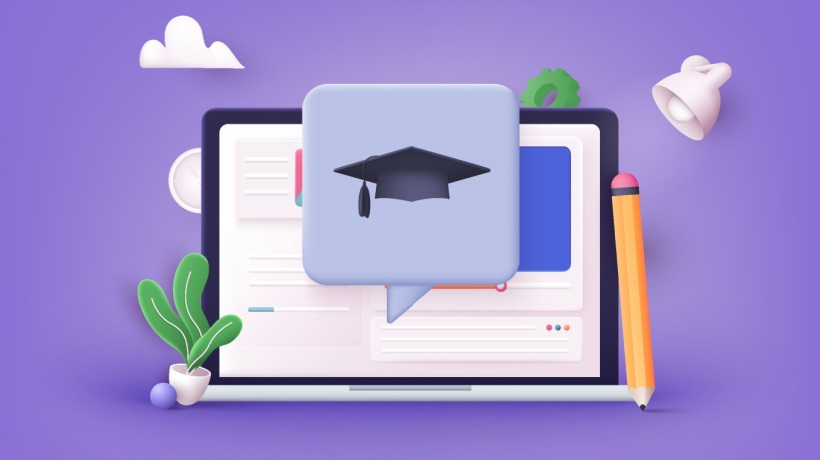Online Learning App Development 101
Today's competitive environment requires new skills and technology. eLearning apps are popular across many age groups. An online learning app can provide adequate educational material for a few bucks and engage students. Creating online learning software is difficult but rewarding. Schools are designed to teach students in real time, which presents a problem. Virtual education requires classrooms to be redesigned. Virtual learning allows students worldwide to learn. Students can learn at their own pace, attend school when convenient, and pursue courses not accessible in their current area.
Why Join The eLearning App Development Industry?
Here are some facts that illustrate how quickly the online learning industry is growing. The moment is here if you want to create an eLearning platform!
- The market for virtual learning is anticipated to grow by 200% between 2020 and 2025. (Source: Forbes)
- Because of online learning, 42% of US firms have seen an increase in revenue. (Source: The Educators)
- 90% of the nations implemented distance learning after the outbreak. (Source: Research and Markets)
- By 2026, the corporate online learning industry is anticipated to expand by 15% and reach $50 billion. (Source: Business Wire)
Online Learning App Must-Haves For Students, Educators, Parents, And Admins
There are a ton of opportunities for mobile learning. Consequently, the market for mobile distance learning apps is also flourishing. The initial step in application design is not to build the application itself. Detecting a problem is the first step. Designing a solution to that issue is the next stage. After that, you can decide how to construct your app.
1. Student Panel Features
Students will be the group that uses an eLearning app the most. You must make sure the UI is appealing but not overly so. The student panel app will have the following standard features, which are listed below:
- Delivery system
Virtual learning apps depend on their content delivery systems. Apps deliver material from a structured database. This database provides app data. Devices, clouds or both can store the database. - Tests, exercises, and quizzes
Tests and quizzes are essential in an online learning program. Teachers can assess student understanding. It also encourages learning. No matter how much the teacher covers, a distance education app should provide tests after every lesson. - Customized learning
Personalized learning doesn't just involve videos or podcasts. It requires software that can adapt to pupils' learning styles. - Games
Gamification uses game-like methods to engage non-gamers. Game-based learning—gamification—is utilized in education. Gamification includes badges and points showing app activity and progress. Reward loops include badges, points, and virtual currency. Gamification mechanics add value to apps, improving engagement. - Push notifications
Push alerts engage pupils and motivate them to learn. Relevant, tailored notifications can be sent anytime. Push notifications can alert students to tests, quizzes, assignment due dates, instructor feedback, and online discussions. - In-app messaging
Teachers can use in-app communications to reward, remind, and urge students to study. Using the mobile app, they can text students. It enhances mobile learning and improves retention. Students can ask questions in the app with one tap. The instructor can then respond promptly or arrange a mutually convenient time to meet. When the instructor replies, the student is notified. - Payment channels
Payment channels can aid web-based learning app development. They can create a paywall or in-app purchases. Payment methods offer security, speed, and other benefits. - Social media
Web-based education apps integrate social media to enhance learning. The app connects learners and allows them to share ideas. Social interaction boosts student engagement and networking. - Simple login
Any app starts with the login page. When logging in takes too long or requires personal details, users will be annoyed. Add Google Login for a simple login. It saves time and lets users use their pre-filled profiles. - Offline studying
Most distance learning apps allow content downloads. Each lesson should have a "download" link. The top of your course list should have a "download all" button.
2. Teacher Panel Features
Teachers need simple web-based learning software. User Interfaces should be straightforward and appealing. Designers can achieve these goals by deleting extraneous functionalities and optimizing interface layouts.
- Signup
Register for a course. An email will confirm your data. You can password-protect your account in the meantime. Log in using your username and password to access your dashboard at any time. - Account settings and profile
Users can modify their password, profile, and account information on the app. - Arrange live classes
This app can arrange and record live classes. Live classes involve video or audio calls with teachers. Class recordings can be used for subsequent revisions. - Alerts
Create push alerts for the virtual education app. Your app could notify you if a student gets stuck. You can receive push notifications when students improve quickly. - Read comments
Teachers can get feedback while creating courses via the app. The teacher can assess student performance and make course improvements. - Answer student questions
Answering student questions is the most crucial element of an online teaching app for teachers. Accessibility is great. It's useless if you can't talk to your teacher. The finest online education apps let teachers receive and resolve student questions. - Engage pupils using text, audio, or video
Distance education apps help teachers with daily responsibilities. Teachers can use a web-based learning platform to send text, audio, or video lessons to students' mobile devices. - Student deadlines and assignments
Teachers can assign tasks and set deadlines. You can also create a series. Students will submit their answers to you. Students will respond to each other under your post.
3. Guardian Or Parent Panel
Guardians look after their kids. The app's capabilities help the guardian understand the child's behavior. This app lets parents track their children's learning. Their cell phones and tablets can also show their kids' activity.
- Signup
App signup is easy. The guardian registers their child and chooses one or more guardians to keep informed. - Track student progress
Virtual apps for parents make it easier to track your kids' schoolwork and provide real-time feedback. The program flags progress reports with yellow, orange, or red lights if your youngster struggles with a concept. They can also track the child's activity and grades. It tracks attendance, exams, and grades for the guardian. It lets them revisit learning content via videos, PDFs, etc. - Contact teachers
It might let parents connect with teachers, ask questions, and learn with their kids. It would improve student learning by improving parent-teacher communication. - Check assignments, tests, and projects
Parents and guardians are able to view assignments, projects, and assessments. It's important for summer-lazy pupils. They'll appreciate their parents' interest. - Push alerts
The app needs push notifications to notify parents of their children's activities and performance. It also means people can act without constantly checking the app, making life easier. - Attendance
Guardians can view student attendance online. The name, photo, attendance percentage, class, and subject are displayed to guardians. - Student leaderboard
Leaderboards rank students. Guardians can track students' progress and encourage them. The app sends messages without teacher involvement. Guardians can easily encourage them when needed.
4. Admin Panel
The admin panel manages websites for owners and administrators. Website functions are on the admin panel that manages content, users, and profiles.
- Supervise
Create and delete accounts, and set up user profiles in user management. User passwords and permissions can be changed. - Plan subscriptions
The app lets admins create subscription plans and upgrade users to new projects. - Manage student data
The admin panel must arrange student data into databases that teachers and departments may search and edit. - Organize community content
Content management lets you upload, edit, and preview app content.
Online Learning App Creation: The Cost
Focus on the student when creating an online app. Consider their interests. It should have the same "aha!" feeling of solving a difficult problem after trying. Consider how the teacher can help the student get there faster. Add material later. Distance learning app development costs rely on these aspects:
- Complexity and features
First, of course, complex eLearning apps with plenty of videos, audio, text, or interactive exercises cost more to build. If you want to add a chatbot to the app to interact with and answer student questions, you'll need to include the expense of developing one. - Platforms
Your solution platform is the second factor. iOS devices cost more to develop an online education service than Android ones. - App developers
App costs depend on the number of developers. One developer costs less than a team. Conversely, a complex application requires more developers to finish on schedule. The target audience might also affect development expenses. Web-based education apps cost more the more complex they are.
Last Words
eLearning apps require time, money, and numerous stakeholders. Many believe creating online learning apps is difficult; a pricey task with many unsolved problems.









